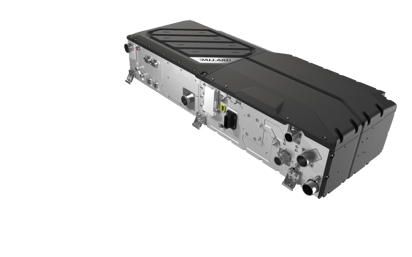
In a milestone for sustainable transportation, Stadler's FLIRT H2 hydrogen-powered train has officially entered service in San Bernardino, California. Developed in collaboration with Ballard Power Systems, the train represents an important step towards zero-emission public transit. Operating along a nine-mile route, the train sets a new benchmark for clean, efficient, and passenger-friendly rail travel in the region.
Introducing California's first hydrogen-powered passenger train
Stadler's fuel cell train entered full service on September 13, 2025 with San Bernardino County Transportation Authority (SBCTA) and operates on the Arrow Corridor, a five-stop route which connects San Bernardino Downtown with Redlands University - running up to 16 trips per day.
The two-car model seats 116 passengers, travels at a maximum speed of 79mph, and covers a range of up to 380 miles on a single hydrogen fill. Refuelling the train takes just 30 minutes, combining sustainability with high operational efficiency.
Commuters have praised its quiet operation, smooth ride, and comfortable design. The train’s zero-emission performance aligns with California’s long-standing environmental leadership and commitment to reducing air pollution. Early feedback indicates strong public support and enthusiasm for the new service, which many see as a welcome alternative to diesel-powered trains.
The train's launch event saw the inaugural service departing from a packed San Bernardino Downtown station - highlighting the community's support for sustainable transit initiatives.
[Footage courtesy of Stadler]
Stadler's collaboration with Ballard
Built in Switzerland, the FLIRT H2 was originally unveiled at InnoTrans 2022 before undergoing extensive testing in the U.S. in 2024. That same year it set a Guinness World Record at Colorado’s Transportation Technology Center by covering 1,742 miles on a single hydrogen fill.
Stadler's successful deployment showcases the strength of the partnership between the two leaders in sustainable transportation technology.
Ballard's FCmove®-HD+ 100kW  fuel cell engine, which powers the train, is the result of a comprehensive engineering collaboration. The integration of six FCmove®-HD+ fuel cells into Stadler's FLIRT H2 platform has been seamless, showcasing the expertise and synergy of the partners.
fuel cell engine, which powers the train, is the result of a comprehensive engineering collaboration. The integration of six FCmove®-HD+ fuel cells into Stadler's FLIRT H2 platform has been seamless, showcasing the expertise and synergy of the partners.
This collaboration has also paved the way for future innovations in zero-emission transportation, supporting California's broader goals of reducing carbon emissions and improving air quality. Stadler's fuel cell solution also offers a practical and sustainable solution for non-electrified routes, offering flexibility for regions where electrification infrastructure is not yet feasible.
Future prospects for hydrogen trains in North America
The successful deployment of Stadler's hydrogen train in San Bernardino sets a precedent for future projects across North America. Both SBCTA and California's State Transportation Agency view the project as a potential blueprint for future hydrogen corridors, enabling cleaner and more efficient regional rail systems, especially in areas where electrification infrastructure is lacking.
As Stadler and Ballard continue to refine hydrogen fuel cell technology, the promise of hydrogen-powered trains extends far beyond California. The collaboration underscores how innovation, partnership, and policy alignment can drive meaningful progress toward a low-carbon transportation future.
As more regions look to reduce their carbon footprint, The experience in San Bernardino illustrates that hydrogen rail systems are not only technologically viable but also welcomed by the public - offering a clear path toward zero-emission public transit in the years ahead.